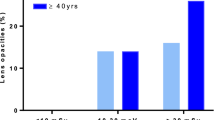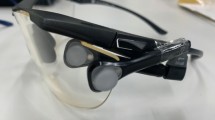Abstract
The eye lens is one of the most sensitive organs for radiation injury and exposure might lead to radiation induced cataract. Eye lens dosimetry in anesthesiology has been published in few clinical trials and an active debate about the causality of radiation induced cataract is still ongoing. Recently, the International Commission on Radiological Protection (ICRP) recommended a reduction in the annual dose limit for occupational exposure for the lens of the eye from 150 to 20 mSv, averaged over a period of 5 years, with the dose in a single year not exceeding 50 mSv. This prospective study investigated eye lens dosimetry in anesthesiology practice during a routine year of professional activity. The radiation exposure measured represented the exposure in a normal working schedule of a random anesthesiologist during 1 month and this cumulative eye lens dose was extrapolated to 1 year. Next, eye lens doses were measured in anesthesiology during neuro-embolisation procedures, radiofrequency ablations or vertebroplasty/kyphoplasty procedures. The eye lens doses are measured in terms of the dose equivalent H p(3) with the Eye-D dosimeter (Radcard, Poland) close to the right eye (on the temple). In 16 anesthesiologists, the estimated annual eye lens doses range from a minimum of 0.4 mSv to a maximum of 3.5 mSv with an average dose of 1.33 mSv. Next, eye lens doses were measured for nine neuro-embolisation procedures, ten radiofrequency ablations and six vertebroplasty/kyphoplasty procedures. Average eye lens doses of 77 ± 76 µSv for neuro-embolisations, 38 ± 34 µSv for cardiac ablations and 40 ± 44 µSv for vertebro-/kyphoplasty procedures were recorded. The maximum doses were respectively 264, 97 and 122 µSv. This study demonstrated that the estimated annual eye lens dose is well below the revised ICRP’s limit of 20 mSv/year. However, we demonstrated high maximum and average doses during neuro-embolisation, cardiac ablation and vertebro-/kyphoplasty procedures. With radiation induced cataract being explained as a possible stochastic effect, without a threshold dose, anesthesiologists who regularly work in a radiological environment should remain vigilant and maintain radiation safety standards at all times. This includes adequately protective equipment (protection shields, apron, thyroid shield and leaded eye wear), keeping distance, routine monitoring and appropriate education.




Similar content being viewed by others
References
Miller DL, Vano E, Bartal G, et al. Occupational radiation protection in interventional radiology: a joint guideline of the Cardiovascular and Interventional Radiology Society of Europe and the Society of Interventional Radiology. J Vasc Interv Radiol. 2010;21:607–15.
Vano E, Kleiman NJ, Duran A, et al. Radiation cataract risk in interventional cardiology personnel. Radiat Res. 2010;174:490–5.
Kleiman NJ. Radiation cataract. Ann ICRP. 2012;41(3–4):80–97.
ICRP. ICRP statement on tissue reactions/early and late effects of radiation in normal tissues and organs—threshold doses for tissue reactions in a radiation protection context. ICRP Publication. Ann ICRP. 2012;41(1–2):1–322.
Arii T, Uchino S, Kubo Y, Kiyama S, Uezono S. Radiation exposure to anaesthetists during endovascular procedures. Anaesthesia. 2015;70(1):47–50.
Anastasian ZH, Strozyk D, Meyers PM, Wang S, Berman MF. Radiation exposure of the anesthesiologist in the neurointerventional suite. Anesthesiology. 2011;114(3):512–20.
Zagorska A, Romanova K, Hristova-Popova J, Vassileva J, Katzarov K. Eye lens exposure to medical staff during endoscopic retrograde cholangiopancreatography. Phys Med. 2015;31(7):781–4.
Harding JJ, Crabbe JC. The lens. In: Davson H, editor. The eye, vol. 3. New York: Academic Press; 1984. p. 207–492.
Brown NP. The lens is more sensitive to radiation than we had believed. Br J Ophthalmol. 1997;81(4):257.
Ainsbury EA, Bouffler SD, Dörr W, Graw J, Muirhead CR, Edwards AA, Cooper J. Radiation cataractogenesis: a review of recent studies. Radiat Res. 2009;172(1):1–9.
Kleiman NJ, Worgul BV. Lens. In: Tasman W, Jaeger EA, editors. Duane’s clinical ophthalmology. Philadelphia: Lippincott & Co.; 1994. p. 1–39.
Merriam GR Jr, Focht EF. A clinical and experimental study of the effect of single and divided doses of radiation on cataract production. Trans Am Ophthalmol Soc. 1962;60:35–52.
Chylack LT Jr, Wolfe JK, Singer DM, Leske MC, Bullimore MA, Bailey IL, Friend J, McCarthy D, Wu SY. The lens opacities classification system III. The Longitudinal Study of Cataract Study Group. Arch Ophthalmol. 1993;111(6):831–6.
Pei X, Bao Y, Chen Y, Li X. Correlation of lens density measured using the Pentacam Scheimpflug system with the Lens Opacities Classification System III grading score and visual acuity in age-related nuclear cataract. Br J Ophthalmol. 2008;92(11):1471–5.
Boal TJ, Pinak M. Dose limits to the lens of the eye: international basic safety standards and related guidance. Ann ICRP. 2015;44(1 Suppl):112–7.
Broughton J, Cantone MC, Ginjaume M, Shah B, Czarwinski R. Implications of the implementation of the revised dose limit to the lens of the eye: the view of IRPA professionals. Ann ICRP. 2015;44(1 Suppl):138–43.
Amis ES Jr. Anesthesiologists in the neurointerventional suite: what is appropriate radiation protection? Anesthesiology. 2011;114(3):477–8.
Le Heron J, Padovani R, Smith I, Czarwinski R. Radiation protection of medical staff. Eur J Radiol. 2010;76(1):20–3.
Dagal A. Radiation safety for anesthesiologists. Curr Opin Anaesthesiol. 2011;24(4):445–50.
Acknowledgments
We want to express sincere gratitude to the SCK·CEN (Belgian Nuclear Research Centre, Mol, Belgium) who delivered the dosimeters and performed the read-out.
Author information
Authors and Affiliations
Corresponding author
Ethics declarations
Conflict of interest
No external funding and no conflict of interest declared.
Rights and permissions
About this article
Cite this article
Vaes, B., Van Keer, K., Struelens, L. et al. Eye lens dosimetry in anesthesiology: a prospective study. J Clin Monit Comput 31, 303–308 (2017). https://doi.org/10.1007/s10877-016-9857-1
Received:
Accepted:
Published:
Issue Date:
DOI: https://doi.org/10.1007/s10877-016-9857-1




